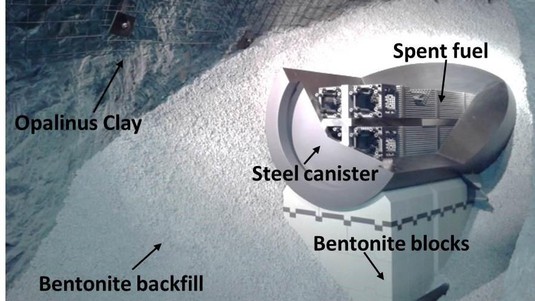Mastering a critical step in storing radioactive waste

Model of a storage tunnel for used fuel elements. © LMS/EPFL, Mont Terri underground lab
An EPFL research project has developed a detailed profile of the sites selected to store radioactive waste from Swiss nuclear power plants. The project also helps identify sites that meet both safety and feasibility requirements.
“Radioactive waste containers are safer the deeper they are buried in rock, but that makes the process much more technically challenging too. I had to consider both of these factors in my thesis, while maintaining a very long-term perspective,” says Valentina Favero, a civil engineer and a researcher in EPFL's Laboratory of Soil Mechanics (LMS) who passed her PhD oral exam on 16 January. Her public defense will take place on 3 March at EPFL.
“Favero's findings will play a role in selecting radioactive waste storage sites in Switzerland,” says Professor Lyesse Laloui, one of her PhD advisors and head of the LMS. “Her work is sure to have major scientific implications and a significant impact on society.”
In 2008, the National Cooperative for the Disposal of Radioactive Waste (Nagra) identified six regions in Switzerland, approved by the Federal Council, that could be used to store radioactive waste. Since then, the list has been whittled down to two regions – northeast Zurich and eastern Jura (Aargau) – on the basis of work done by Favero for her PhD. According to Favero, these two sites meet the safety and feasibility requirements of storing highly radioactive waste from Swiss nuclear power plants, as well as low-activity waste, which is produced by medical, research and engineering activities. But Favero’s contributions do not end there: her research will also be used in a more detailed study of the sites approved by the Federal Council during the next step of the selection process. This study was granted financial support from Nagra.
Detailed analysis of Opalinus clay
What was Favero’s approach in her PhD? First, she learned more about the properties of Opalinus clay, which is the type of rock commonly used in Switzerland for storing radioactive waste. She studied the clay’s characteristics at different depths in the six regions short-listed by Nagra. This was meticulous work, as the clay’s properties vary with depth.
Favero noted all of the clay’s physical, mechanical and chemical features, and studied how the heat given off by radioactive waste containers affects both the clay and the materials (such as bentonite) used to surround the canisters – materials that may expand or contract in the presence of heat. She also identified the chemical composition of the liquid found in the clay's pores, since the composition may change in response to heat. She needed to investigate other hydraulic properties of rocks as well, including “suction”, which refers to rocks decreasing in volume when they become partially saturated. In order to see the big picture – how these properties, taken together, could lead to radiation leaks – Favero had to crosslink her data. That was a laborious task, but it led to one of the key outcomes of her PhD.
Desaturation and convergence
“The deeper you go, the more rigid and impermeable the rocks are. And that’s exactly what we want – a solid barrier between us and the radioactive waste. But the technical challenges also increase the further down you go,” says Favero. Even the process of drilling the tunnel that the radioactive waste containers will go through will affect how the surrounding rocks behave.
This led Favero to analyze how the materials will react during the various phases of this process: “Rocks located at the upper end of the tunnel will be exposed to air,” she explains. “That will lead to desaturation, in which some of the water held in the rocks evaporates. As they dry out, the materials could crack, which would make them more permeable. Yet we need impermeable rocks to achieve an effective seal.”
The researcher carefully studied this phenomenon and the related risks. Leaving no stone unturned, Favero also looked at the redistribution of forces when the tunnel is dug. This is called convergence, and it refers to the tunnel’s tendency to collapse on itself. The deeper the tunnel, the greater the convergence.
Favero’s exhaustive research was instrumental for the Nagra in selecting the best two sites for storing radioactive waste in Switzerland and determining the safest and most technically feasible depth at which to place the steel canisters.
Favero’s public defense will be held on 3 March at the EPFL, BP Building, room 5202 , 5.30pm.
Subscriptions:http://doodle.com/poll/78wd2da7x8gz47ur
Favero's thesis:

